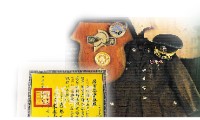| |
|
|
1945 |
|
On August 15, Japan declaring her surrender unconditionally ended the colonial rule that had lasted for 51 years in Taiwan . On October 8, the first government troops landed in Taiwan by Tam-sui, and then administrative officers and other troops of military police, police and Police Headquarters followed. |
1947 |
|
For settling down the dependents accompanying with the troops to Taiwan , military dependents' villages appeared hereafter. |
1948 |
|
As the civil war between the Kuomintung and Chinese Communist Party intensified, more and more troops and their dependents withdrew to Taiwan , and thus the military dependents' villages increased gradually all over Taiwan . ˇ§ Shih-Shih South Village ,ˇ¨ built for the 44 th armory of the Combined Services Force Headquarters, was the first military dependents' village in Taipei city. |
1949 |
|
As the Nationalist government failed in the civil war between Kuomintung and Chinese Communist Party, it took 600 thousand soldiers to withdraw to Taiwan . Most dependents only could stay in schools, theaters, temples or bomb shelters temporarily. Some of them looked for materials to built temporary houses to dwell in. In order to stabilize the morale of the armed force, the government organized the ˇ§Military Dependents Management Divisionˇ¨ to deal with the affairs of dependents. |
1950 |
|
The amount of military dependents' villages increased rapidly. The troops were busy searching for places, and offered manpower to build houses with bamboos, mud, and husks of grains barely. Each household used to have more than 6 or 7 members, but was allotted a space as less as 5 to 6 pings (1 ping=36 square feet) and as large as 8 to 10 pings. All houses were adjacent one by one so closely that there was no space between two houses. Only a narrow lane separated one row of houses from another. Some military dependents' villages were surrounded by bamboo fences, and thus ˇ§Bamboo Fencesˇ¨ became a synonym of military dependents' villages. |
1953 |
|
On July 16, the government armed force raided Dong-shan Island . It's the last time that the government armed force launched a large-scale military operation on the coastal area of mainland China . |
1954 |
|
On January 23, 14 thousand anti-communist heroes who had participated in the Korean War came to Taiwan in 3 groups. To commemorate this special day, January 23 was called ˇ§123, Freedom Day.ˇ¨ |
1955 |
|
The government armed force failed in the battle of Ichiangshan, more than 38 thousand soldiers, dependents and civilians on Dachen Islands withdrew to Taiwan. |
1956 |
|
Madame Chiang Kai-shek raised funds from the industry and business to build military dependents houses. Many dependents' villages were built hereafter.
According to the census this year, external provincial citizens amounted to 1.2 million, among which young and middle-aged persons occupied one half. |
1958 |
|
On August 28, Canon War erupted in Kinmen. The PRC artillery bombarded Kinmen Islands with 480 thousand bombs totally. |
1959 |
|
On November 1, the Veterans General Hospital was inaugurated in Shih-Pai, Taipei to serve soldiers and their dependents mainly. As the National Health Insurance was carried out, this hospital began to serve other civilians, but a large proportion of the clients were still the honorary soldiers. |
1961 |
|
On September 2, severe typhoon Pamela raided Taiwan with strong wind and heavy rain that brought up serious damage. Especially, military dependents' villages' structures were so humble that they suffered from terrible damage. |
1964 |
|
The 5 th division of the General Political Warfare Department was set up to take over military dependents affairs, such as the construction, repair and allotment of dependents' houses and medical service. |
1970 |
|
Ministry of National Defense set up ˇ§Military Dependents Affairs Management Division,ˇ¨ which dealt with the reconstruction and move of military dependents' villages, housing management, and military dependents service. |
1971 |
|
ˇ§Bamboo Fencesˇ¨ or military dependents' villages built in 1950s were 20 years old. After experiencing several typhoons' attack, these villages were dilapidated. Thus the proportion of reconstruction or move of villages increased. As for the origin of funds, some came from the Military's special aids, and others were raised by honorary soldiers themselves. The newly built villages, with RC structure in place of the original cottages, improved honorary soldiers and their dependents' living quality a lot.
On October 25, the ROC was forced out of the United Nations. |
1977 |
|
Premier Chiang Ching-ku o set up the principle of ˇ§Reconstruction of Old Military Dependents' Villages.ˇ¨ The Military offered land and cooperated with local provincial and municipal governments in building public housing. |
1979 |
|
On January 1, the United States cut ties with the ROC, and established formal diplomatic relations with the PRC. |
1980 |
|
Taipei City Government and Ministry of National Defense signed ˇ§Agreement on Cooperation in Trying to Build Public Housing with Land of Military Dependents ' Villages.ˇ¨ Both sides began to cooperate to reconstruct military dependents' villages. Reconstruction of military dependents' villages not only improved the living environment of dependents and offered citizens in Taipei city affordable housing, but also contributed to the urban renewal and speeded up urban development. |
1981 |
|
The pace of reconstruction of military dependents' villages speeded up. Being different from the original villages consisting of single-story or two-story houses, more-than-ten-story villages appeared one by one. ˇ§Bamboo Fences villagesˇ¨ became history formally. |
1982 |
|
According to a survey of Women's Federation in China , there were 879 military dependents' villages all over Taiwan including 98535 households and 467316 persons amounted. |
1987 |
|
On July 5, the Emergency Decree that had been enforced for 38 years was formally lifted, followed by lifting of the ban on parties and newspapers.
On October 5, the Administrative Yuan passed the ˇ§Regulations for permitting Taiwan Compatriots to Visit Their Relatives on the Mainland.ˇ¨ Those families who had separated for almost 40 years because of civil war finally could reunite with each other. |
1992 |
|
On July 16, the Legislative Yuan passed the ˇ§Act Governing Relations between Peoples of the Taiwan Area and the Mainland Area and Its Enforcement Rules.ˇ¨ The relations across the Taiwan Strait entered a new stage of legalization. |
1996 |
|
On January 1, the Legislative Yuan passed the ˇ§Act for Rebuilding Old Quarters for Military Dependents.ˇ¨ |
1997 |
|
The Legislative Yuan passed the ˇ§Fund for Rebuilding Old Quarters for Military Dependents. ˇ¨ |
1998 |
|
Taipei City Government proposed to build a military dependents' villages museum and preserve the first military dependents' villages in Taipei city, ˇ§ Shih-Shih South Village ˇ¨, as a historical testimony. |
1999 |
|
On May 4, all dwellers in Shih-Shih South Village moved out. The village was torn down, but a piece of land about 0.5 hectare was preserved as a reservation of military dependents' villages culture. |
2005 |
|
Since Taipei City Government cooperated with the Military in reconstructing dependents' villages in 1980, 77 villages in total have been reconstructed with 29453 public houses built. |
|
|
|
| |
Source of Data: |
|
Gu, Bi-ling, et al. As Sentimentally Attached to Military Dependents' Villages. Department of Information, Taipei City Government, 1999. |



